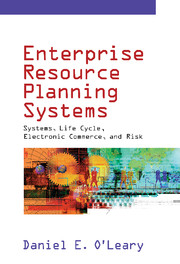Book contents
- Frontmatter
- Contents
- Acknowledgments
- PART ONE INTRODUCTION AND BACKGROUND
- PART TWO ERP SYSTEMS
- PART THREE ERP LIFE CYCLE
- 7 Deciding to Go ERP
- 8 Choosing an ERP System
- 9 Designing ERP Systems: Should Business Processes or ERP Software Be Changed?
- 10 Designing ERP Systems: Choosing Standard Models, Artifacts, and Processes
- 11 Implementing ERP Systems: Big Bang versus Phased
- 12 After Going Live
- 13 Training
- PART FOUR ELECTRONIC COMMERCE AND RISK
- Index
10 - Designing ERP Systems: Choosing Standard Models, Artifacts, and Processes
from PART THREE - ERP LIFE CYCLE
Published online by Cambridge University Press: 05 June 2012
- Frontmatter
- Contents
- Acknowledgments
- PART ONE INTRODUCTION AND BACKGROUND
- PART TWO ERP SYSTEMS
- PART THREE ERP LIFE CYCLE
- 7 Deciding to Go ERP
- 8 Choosing an ERP System
- 9 Designing ERP Systems: Should Business Processes or ERP Software Be Changed?
- 10 Designing ERP Systems: Choosing Standard Models, Artifacts, and Processes
- 11 Implementing ERP Systems: Big Bang versus Phased
- 12 After Going Live
- 13 Training
- PART FOUR ELECTRONIC COMMERCE AND RISK
- Index
Summary
One of the critical sets of decisions that needs to be made in any ERP concerns the choice of common standard MAPs – that is, models (e.g., organization models), artifacts (e.g., vendor numbering schemes and lists), and processes (e.g., order management). Two expressions, “common … and global” and “input by many,” have received attention as guidelines to help implement those common MAPs in some companies (see CIO 1996). Rather than following the historical process of each business unit choosing its own MAPs, as is often done in legacy systems, an ERP-structured company will use the same MAPs for each business unit. However, the choice, implementation, and use of common MAPs is not easy. Within a given firm there are likely to be conflicts over those MAPs. As a result, this chapter addresses the following questions.
Why are MAPs important?
Where do common MAPs come from?
Why do firms need common MAPs for ERP systems?
Why didn't firms have common MAPs prior to ERP systems?
Why is it difficult to choose common standards?
What are some choice motivations?
In order to develop “common … and global” processes, what methods have been used to choose common ERP models, artifacts, and processes so that there is “input by many”?
Why Are MAPs Important?
The quality of the MAPs will have a huge impact on the overall success of the ERP implementation.
- Type
- Chapter
- Information
- Enterprise Resource Planning SystemsSystems, Life Cycle, Electronic Commerce, and Risk, pp. 141 - 150Publisher: Cambridge University PressPrint publication year: 2000

